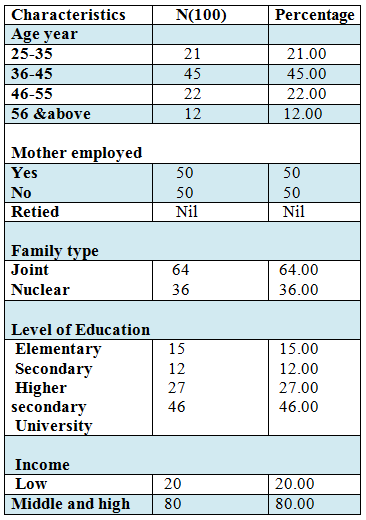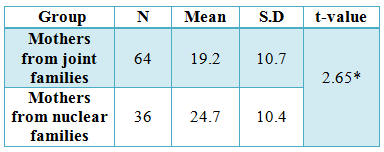
Depression Level of Mothers having Children with Disability
Abstract:::
The Child’s disability stresses the mother the most and this stress shows itself in the form of depression which in turn affect the mothers. The main objective of the present study is to evaluate the depression level of mothers having a child with disability. Samples of 100 mothers having children with disability were selected. Out of these 50 were working and 50 were non-working, belonging to nuclear and joint families. The tool used for the study was standardized Beck Depression Inventory. Overall the results indicate that depression level is higher among mothers with disabled daughter belonging to nuclear families. The findings to nuclear families are more depressed than their counterparts.
Keyword: Depression, Mothers, Children, Disability.
Introduction:
In Everyday use of language the term depression is meant to describe the feelings such as sadness, disappointment, hopelessness and abatement. In fact depression isa psychiatric disorder in which the patient’s mood becomes distressed. Today undiagnosed and untreated depressions have become major health problems throughout. The world. Nowadays depression is so common that is some time called the ‘‘psychological flu’’. Depression is one of the most common psychiatric disorder and life time prevalence of depression is very high among woman in world approximately 12.25%. In 2000, depression was the fourth reason for loss of employment and in 2002 it was the second incapacitating illness among all psychical and mental illnesses (Ghoreshizadeh 2005). According to WHO approximately 15 of world population suffered from severe mental disorders and 15% suffer minor mental disorder (WHO 1990). On the other hand, in view of the family being nuclear and also attention to the fact that disability of one of the children can also too often leave negative effects on all the family members and their functions, and cause higher degree of stress, depression and anger among the parents of disabled children (Little 2003). The studies have shown that the most effected person in the family with a disabled child is usually mother.Mother of children with disabilities often experience greater stress and emotional demand then do other mothers (Smith TB & other 1993). Mothershave to undertake too much stress because they are alone with their children in daily life. Not all mothers of children with disabilities have difficulties of adaptation even they have to face highly stressful life situations. However it has been explained that the children and mothers are at risk of stress related problems when mother are overburdened by the demand of care giving, earning, a living and other responsibilities. Several studies have been conducted to investigate the effect of disability of children on depression and anxiety level of their mother in different parts of the world. The present study is being conducted to ascertain the level of depression among mothers (working and non- working) having disables child/ children belonging to nuclear and joint families.
Objective:
Hypotheses:
Method:
A tool of 100 mothers having disabled children have been selected as participants for the study. All the participants have been selected from Ahmedabad, state of Gujarat. Participants have been divided into two groups i.e. 50 working mothers and 50 non-working mothers. Out of the total sample 64 mothers belong to a joint families and 36 to nuclear families. Further there were 46 mothers whom disabled daughters have been born and 54 were those who have disabled sons.
Tool:
The tool used to collect the data was Back Depression Inventory (BDI). It is a 21 items self-reported measure of cognitive, affective and somatic dimensions of depression. Each item contains four statements. The symptoms in the inventory are divided in to mood, thought, motivational and physical sets. According to Back(1967) the mean BDI scores for the low, middle, moderate, severe and extreme depression are as follow:
01-10 Low, These ups and downs are considered normal.
11-16 Mild mood disturbance.
17-20 Borderline clinical depression.
21-30 Moderate depression.
31-40 Severe depression.
40-above Extreme depression.
Statistical Analysis:
Mean, standard deviation and t-test were used to analyse the data. SPSS has been used to get statistic analysis.
Result:
The present study was conducted with equal distribution of participants in two categories as working mothers with disabled child and non-working mothers with disabled child. The mothers were taken from both nuclear and joint families. The demographic characteristic of the participants shown in table- 1.
Table- 1. Characteristics of sample

Table- 1 shows that 45% of mothers belonged to 36-45 years group, 22% of mothers belong to 46-55 years age group, 21% of mothers belonged to 25-35 years age group and 12% of mothers belonged 56 years and above age group. 50% of mothers were working and 50% non-working. 64% of mothers were from joint families and 36% from nuclear families. Mother’s education level was, 15% from elementary(n=15), 12% from second (n=12), 27 from higher secondary (n=27) and 46% from university level(n=46). 20%(n=20) of the mothers were from low income families and 80%(n=80) from middle and high income families.
Table- 2: N, mean score (depression), standard deviation and t-value of working & non-working mothers

0.01level significant
The table-2 indicates that working mothers are more depressed than non-working mothers. Table also indicates that there is a significant difference in the depression level of working and non-working mothers.
Table- 3: N, mean score (depression), standard deviation and t-value of mothers having disabled child belonging to joint and nuclear families

0.01 level significant
Table- 3 indicates that mothers from nuclear families and more depressed than mothers from joint families.
Table- 4: N, mean score (depression), standard deviation and t-value of mothers with disabled girl and boy child.

0.05 level significant
Table 4 indicates that mothers with disabled with disabled girl child have a bit higher level of depression than the mother with boy child. There is no significant difference between the two groups of mother (mother disabled girl and disabled boy child)
Discussion:
Evidence of life threatening or long lasting disease/ disability in children is a condition which causes stress for mothers and can predispose them to depressive disorders. The result of study (Table- 1) shows that the working and non-working mothers belonging to joint and nuclear families having disabled children were from the different age groups ranging from 25 years to 60 years. Result of the Table 2 indicate the working mothers with disabled children have higher depression level than non-working mothers with disabled children. The mean score of depression for working mother is 25-45 and that for non-working mothers with disabled children. The mean score of depression working mothers is 25.45 and for non-working mothers is 18.3. The result t-value is 2.68, which is significant at both the levels. Hence, out hypothesises- 1 i.e. working mothers with disabled children will have higher level of depression than non-working mothers is thus accepted and confirmed. The results of the present study that working mothers with disabled children are more depressed than non-working mothers is confirmed by other studies( Ganong L. & others 2003). We can’t deny the fact that mothers have to shoulder almost all the responsibilities of their children like rearing and caring, hence they are more in touch with them and have to face more difficulties in handling and management of their children. These responsibilities are likely to be more difficult to shoulder if there is a physically or mentally challenged (disabled) children in family. It has been found that is the disabled children and their mother live in nuclear families, the mother in joint families. In the light of these finding of previous researchers, our results of the table- 3 shows that the mothers with disabled children from nuclear families have higher depression than counterparts. The result t-value 2.6 is significant at both the levels, hence our hypothesis- 2 i.e mothers with disabled children from nuclear families are more depressed is accepted and confirmed by previous research studies (Little 2003). The result of the table - 4 shows that the depression level of the mothers having a disabled daughter is a bit higher than mothers with disabled son. But the difference between two groups with respect to the depression level is not significant. Hence, our hypothesis- 3 is rejected. From the present study’s discussion and existing literature is clear that mothers with a disabled daughter or son are overall much depressed and dejected than the mothers with normal children.
Conclusion:
The present study intended to evaluate the depression level of mothers having a disabled child provided further support to the existing literature in the said field. From the present study it can be concluded without any hesitation that the working mothers and mothers with disabled children from nuclear families are highly depressed than their counterpart.
Limitations of the study:
- The sample was small.
- The study was conducted in the districts of one state only (Gujarat).
- The study involved only small number of variables for investigation.
- Divorced and windowed mother having disabled children were not included I the study.
Reference::
***************************************************
Dr.Pallavi R.Chauhan
Assist. Professor (Psychology),
Idar Anjana Patidar Arts & P. N. Patel Commerce College
Idar-383430 (S. K)
Cell: + 91-9978918646
Email: drpalchauhan@yahoo.co.in



Home | Archive | Advisory Committee | Contact us